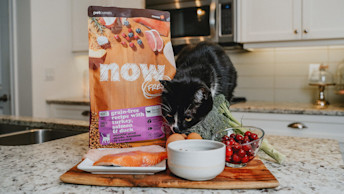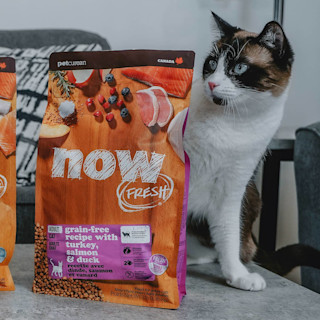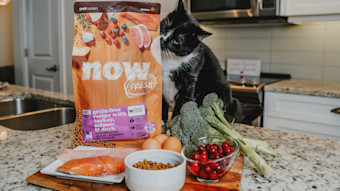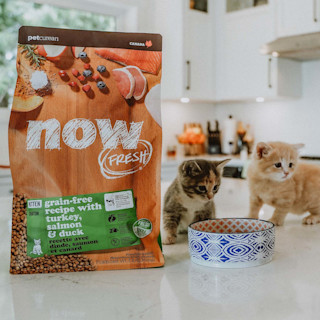July 29, 2025
What Are Meat By-Products in Cat Food & Which Protein's Best?

With so many different cat food recipes made with different types of protein to choose from, we know it can be hard to make the right decision. You might be asking questions like “What are the best protein sources for cats?", “What are meat by-products in cat food?”, or “How do I read an ingredient panel to know what’s actually in my cat’s food?”. You might also be wondering what the difference between chicken meal and chicken by-product meal is, or deboned turkey vs. turkey meal, or what it means when just “meat meal” is listed.
Meat protein content and sources are often marketed as the most important part of a pet food, and when there’s so many different kinds out there, it can make the decision feel overwhelming. To help you out next time you’re at the local pet food shop or researching online, let’s dig into the what’s and why’s of all things protein!
What Is Protein, and Why Do Cats Need It?
Protein is one of three macronutrients (meaning nutrients the body requires in large amounts), along with fat and carbohydrates, which make up pet foods. Proteins are made of building blocks called amino acids, which are important for many key functions in the body, including healthy muscle development and recovery.
Amino acids from protein are essential for healthy muscles – no other nutrient can do this task! Meat ingredients are one of the main sources of this important nutrient, and also play an important role in contributing to the flavour and texture of your cat’s meal.
In total, cats require 22 amino acids. 12 of these amino acids are called non-essential, meaning the body can make them using other nutrients. The remaining 10 are called essential amino acids because cats must receive them through their diet. Cats require a unique amino acid-like compound called taurine, which must be provided in the cat’s diet. It is found naturally in animal-based protein sources.
What’s the Best Protein Source for Cats
It's important to note that it’s not the protein source that matters most, rather, it’s about finding the right balance of amino acids. This is why there is no single best protein source for cats, however whole eggs are what’s considered a 'perfect' protein because they contain all the essential amino acids cats need.
Ultimately, it is the amino acids found in the protein that the body needs. In fact, whether an amino acid comes from an animal or plant source doesn’t matter to the body – it just knows it needs that amino acid. Choosing recipes made with complementary meat and plant-based protein ingredients (like sustainably produced peas), meaning they balance each other out to complete the amino acid profile, is often a great choice.

Our Recommendation
Complete & Balanced Cat Food Made with Fresh Meats & Fish
Our collection of premium-quality cat food recipes are made simply with fresh meats and fish and nutrient-rich fruits and veggies for easily digested nutrition and an irresistibly yummy flavour.
View cat foodEvery protein source, from fresh meat and whole eggs, to dried meat meals and legumes, contains different amounts of those essential amino acids, which means a diet that contains multiple protein sources is a great way to help ensure your pet is getting the amino acids they need.
Another option is to consider a varied diet and switching up proteins for your cat every so often. A varied diet switching up proteins for your cat comes with benefits. Research even suggests that feeding a variety of protein and other foods, especially when started at a young age, can help the good gut bacteria easily recognize new food sources2. This may help discourage the development of food sensitivities later in life.
What Are Meat Meals and Meat By-Product Meals in Cat Food?
Meat Meals
Named meat meals are a concentrated, dried protein ingredient from a single animal source. These would appear on an ingredient panel as “chicken meal” or “lamb meal” – note only a single, named, animal source. Meat meals that appear on a label without a specific named animal source (also known as "unnamed meat meals") can come from several different unknown sources and are best to be avoided.
Named meat meals are created by taking fresh meat, nutrient rich bones and cartilage, cooking it to remove the water and fat, and then grinding the dried meat into a concentrated, protein-rich powder.
Meat By-Product Meals
Meat by-products include all the other parts of the body other than muscle meat. This can include things like nutrient-rich organ meats, as well as undesirable ingredients like heads and feet.
Meat by-product meals are created using the same cooking process as meat meals and may be from a single animal source, but the actual animal parts in the meal can be a wide array of things. On an ingredient panel, this would be labelled as “chicken by-product meal” or “pork by-product meal.”
Are Meat By-Products Bad for Cats?
There are no set inclusion levels for the types of by-products that can be used in by-product meals. This means it’s often made up of a wide array of ingredients that vary in nutritional quality, from liver to chicken feet. So, while some batches of a by-product meal may be well made and highly nutritious, it's impossible to know for sure.
When it comes down to choosing the right recipe for your cat, a good rule to live by is to look for simple, whole ingredients you recognize from your own grocery shopping. Foods like fresh meats, vegetables, and fruits with familiar ingredient names are an easy way to understand exactly what you’re feeding your cat.
How Does Fresh Meat Compare to Meat Meals?
Named meat meals can be very high-quality sources of protein, but fresh meat does offer a few key benefits. First, and most importantly, is that fresh meat does not go through the separate high heat cooking process that meat meals do. Fresh meat is minimally processed, meaning its cooked only once, which helps to preserve nutrients and deliver the best nutritional value to your cat. Because it’s less processed, it’s also easy for pets to digest, making it a great option for cats with sensitive stomachs, and adds a great taste to your pet’s meal.
Research published in the journal Animals (Montegiove et al, 2022) has shown that kibble using only fresh meats is higher in amino acid content as compared to those using only meat meals or a combination of the two. The authors found that dry pet food using only fresh chicken meat was the highest in essential amino acids, branched-chain amino acids, and taurine. It also had a higher amount of monounsaturated and polyunsaturated fatty acids. In addition, its digestibility was the highest of all foods tested. These findings make the fresh-meat-based formulation a preferable choice as dry pet food.

Our Recommendation
Premium Cat Food Made with Fresh Meats & Fish
Our cat food recipes use minimally processed fresh de-boned meats and fish, like turkey, salmon and duck, whole eggs, with no by-product meals.
View cat foodSecond, meat meals contain bone, meaning they usually have a high level of minerals, namely phosphorus, calcium, and magnesium. Fresh meats do not contain bone, meaning the foods made with them are lower in mineral content. This controlled mineral content can help with health issues, such as kidney disease or urinary issues like struvite crystals, which can be related to high mineral content.
Though fresh meat has numerous benefits, it does often come with a higher cost as compared to concentrated meat meals. This is because fresh meats have not yet been processed and are still in their raw form. When fresh meat is processed into a meat meal, the moisture is removed to create a concentrated protein. This means that it can take 3-5 lbs of fresh meat to create 1 lb of meat meal. It also means that more fresh meat is required in fresh meat-only recipes to achieve the same level of protein as a meat meal-only cat food.
Pairing fresh meats with complimentary protein-rich plant ingredients and eggs is a beneficial way to achieve the desired level of protein while making sure your cat is getting a variety of premium-quality protein sources.
Simply put, fresh meat costs more. Fresh meat is high in moisture, so more meat is required to reach the ideal protein levels than a meat meal recipe. Blending complementary fresh meat with complementary egg and plant ingredients is a great way to complete the protein profile.

How Much Protein Does a Cat Need?
As with most things in life, it’s important to consider both quality and quantity of protein. But, don’t fall into the trap of thinking more protein is automatically better!
Cats (and humans, for that matter), can only use so much protein for those important functions like muscle development. Anything more than the amount they need can turn into body fat or be passed out of the body in urine.
It’s important to remember that every cat is different, and the amount of protein they need will vary depending on their size, age, and activity level. According to the American Association of Feed Control Officials (AAFCO), which is the primary organization that provides recommendations for pet food in North America, adult cats require a minimum of 26% protein in their food (on a dry matter basis). From our experience, most cats do great on a diet ranging from 28-32%. Highly active cats and kittens usually will need a higher protein percentage to keep them in tip-top shape and support their growth and development.

Our Recommendation
Premium-Quality Kitten Food for Growing Cats
Your kitten's first year lays the foundation for a good life, so we’ve crafted our kitten food with premium-quality ingredients like fresh meats and fish to support your cat’s healthy development.
View all kitten foodIn Conclusion
Not all protein sources are created equally, and more protein does not mean better nutrition. Protein serves specific functions in the body and can contribute to the palatability of a food. Certain functions can only be completed by using amino acids from protein, but anything provided in excess is not beneficial and may contribute to health issues down the road. When choosing a food for your cat, ensure that it is compete and balanced for their life stage, and that the ingredients used are those which you feel best suit your pet’s needs and palate, and your values.
Montegiove, N., Calzoni, E., Cesaretti, A., Pellegrino, RM., Emiliani, C., Pellegrino, A., & Leonardi, L.2022. The Hard Choice about Dry Pet Food: Comparison of Protein and Lipid Nutritional Qualities and Digestibility of Three Different Chicken-Based Formulations. Animals. Vol 12(12).
Castellazzi, AM., Valsecchi, C., Caimmi, S., Licari, A., Marseglia, A., Leoni, MC., Caimmi, D., Miraglia del Giudice, M., Leonardi, S., La Rosa, M., & Marseglia, GL. 2013. Probiotics and food allergy. Ital J Pediatr. Vol 39(47).
Authors



